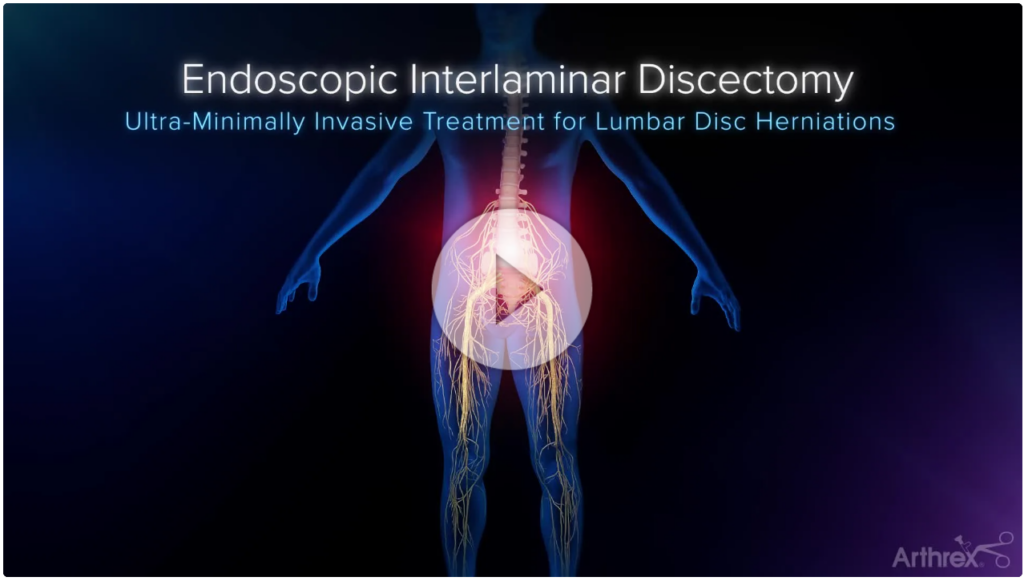Ultra-minimally invasive endoscopic spine surgery (UMIESS) is an advanced surgical technique designed to treat various spinal conditions with minimal disruption to surrounding tissues. This approach uses a small tubular endoscope equipped with a camera and specialized surgical tools, allowing surgeons to access the spine through tiny incisions. The procedure is performed under real-time visualization, enhancing precision and safety.
Key Features and Benefits
- Patient-Centered Design:
- Reduced Pain and Trauma: By preserving muscles and ligaments, UMIESS significantly reduces post-operative pain and the risk of scarring.
- Faster Recovery: Patients often experience shorter hospital stays, quicker mobilization, and a faster return to daily activities.
- Minimized Risk: The smaller incision and reduced tissue manipulation lower the risk of complications such as infection or nerve damage.
- Conditions Treated:
- Herniated discs
- Spinal stenosis
- Degenerative disc disease
- Radiculopathy (nerve pain)
- Spondylolisthesis
- Select spinal tumors or infections
- Procedural Solutions:
- Patient Guides:
- Procedure Highlights:
- Real-Time Visualization: The endoscopic camera provides a magnified view of the surgical site, enhancing precision.
- Small Incisions: Typically 1-2 centimeters, these incisions lead to minimal scarring.
- Local Anesthesia: Many procedures can be done under local or regional anesthesia, reducing systemic risks.
- Targeted Approach: Precise targeting of the affected area avoids unnecessary disruption to healthy tissues.
- Patient Experience:
- Outpatient or Short Hospital Stay: Many patients can go home the same day or after a brief observation period.
- Lower Dependence on Pain Medications: Reduced post-operative pain may decrease the need for opioids.
- Enhanced Quality of Life: Early pain relief and rapid recovery enable patients to return to work and daily routines sooner.
- Patient Testimonial
Comparing UMIESS to Traditional Spine Surgery
Traditional open spine surgery often involves large incisions, significant muscle retraction, and longer recovery periods. In contrast, UMIESS offers a less invasive alternative with comparable or superior outcomes for many conditions. This approach is particularly suited for patients seeking a quicker recovery and a lower risk of complications.
Conclusion
Ultra-minimally invasive endoscopic spine surgery represents a transformative step in spinal care. By focusing on the patient’s comfort, safety, and recovery, this innovative technique aligns with the goals of personalized, efficient, and effective medical care. Patients considering this option should consult a spine specialist to determine if it is appropriate for their specific condition and health goals.
Advantages of Ultra-Minimally Invasive Spine Surgery (Ultra MIS) vs. Traditional Minimally Invasive Spine Surgery (MIS)
Ultra-Minimally Invasive Spine Surgery (Ultra MIS) builds upon the principles of traditional Minimally Invasive Spine Surgery (MIS) while leveraging advanced technologies and techniques for even greater patient benefits. Below are key areas where Ultra MIS demonstrates advantages:
1. Incision Size and Tissue Preservation
- Ultra MIS:
Utilizes incisions typically 5-10 millimeters in length, compared to larger ones in traditional MIS. Advanced endoscopic tools minimize disruption to surrounding muscles, ligaments, and soft tissue.- Advantage: Reduced scarring and less post-operative pain.
- MIS:
Requires relatively larger incisions (1-2 centimeters) and retractors to access the spine. Although less invasive than open surgery, some muscle dissection is still needed.
2. Visualization and Precision
- Ultra MIS:
Employs high-definition endoscopes with real-time, magnified visualization, allowing for precise targeting of the affected area.- Advantage: Enhanced accuracy, particularly in treating complex or delicate structures, with a lower risk of collateral tissue damage.
- MIS:
Uses microscopes or fluoroscopic guidance, which may provide less magnified or detailed views compared to endoscopic imaging.
3. Anesthesia Options
- Ultra MIS:
Can often be performed under local anesthesia with sedation, reducing risks associated with general anesthesia, particularly for older patients or those with comorbidities.- Advantage: Faster recovery from anesthesia and fewer systemic complications.
- MIS:
Typically performed under general anesthesia, which may prolong recovery time and increase risks in certain populations.
4. Post-Operative Recovery
- Ultra MIS:
Patients often experience a quicker recovery due to minimal tissue disruption. Many procedures are outpatient or involve a very short hospital stay.- Advantage: Earlier return to work and daily activities, typically within days to a few weeks.
- MIS:
Recovery is faster than traditional open surgery but may still require a longer rehabilitation period compared to Ultra MIS.
5. Pain and Post-Operative Care
- Ultra MIS:
Minimal trauma leads to reduced post-operative pain, often eliminating or reducing the need for opioid medications.- Advantage: Safer recovery with fewer risks of addiction or medication side effects.
- MIS:
May require more post-operative pain management due to greater soft tissue manipulation.
6. Risk of Complications
- Ultra MIS:
The reduced incision size and precise targeting decrease the likelihood of complications such as infection, blood loss, and nerve damage.- Advantage: Improved safety profile, especially for high-risk patients.
- MIS:
While less invasive than open surgery, there is still a higher risk of complications compared to Ultra MIS due to larger access points.
7. Patient Satisfaction
- Ultra MIS:
Provides improved cosmetic outcomes (smaller scars), less pain, and a quicker return to normalcy, leading to higher overall patient satisfaction.- Advantage: Better alignment with patient-centered care goals.
- MIS:
Offers good outcomes compared to open surgery but does not achieve the same level of satisfaction in terms of recovery speed and comfort as Ultra MIS.
Conclusion
Ultra-Minimally Invasive Spine Surgery represents a significant leap forward from traditional MIS techniques. By further minimizing tissue disruption, improving precision, and expediting recovery, Ultra MIS offers a superior option for patients who prioritize rapid, safe, and effective relief from spinal conditions.





